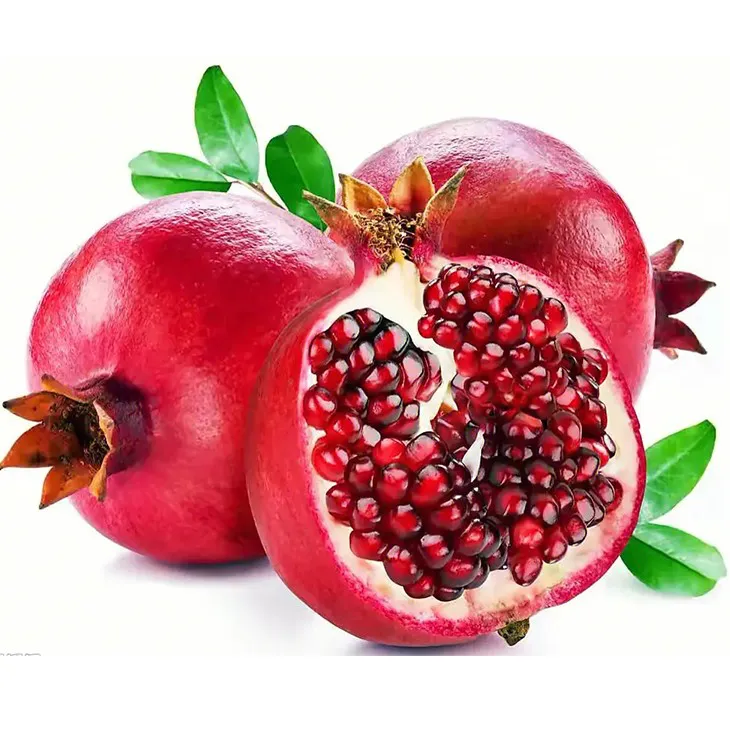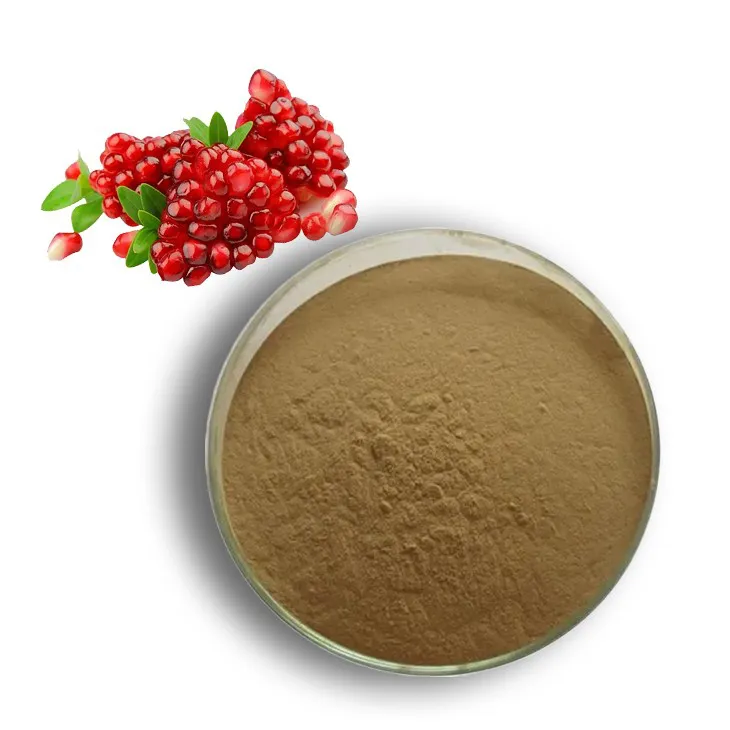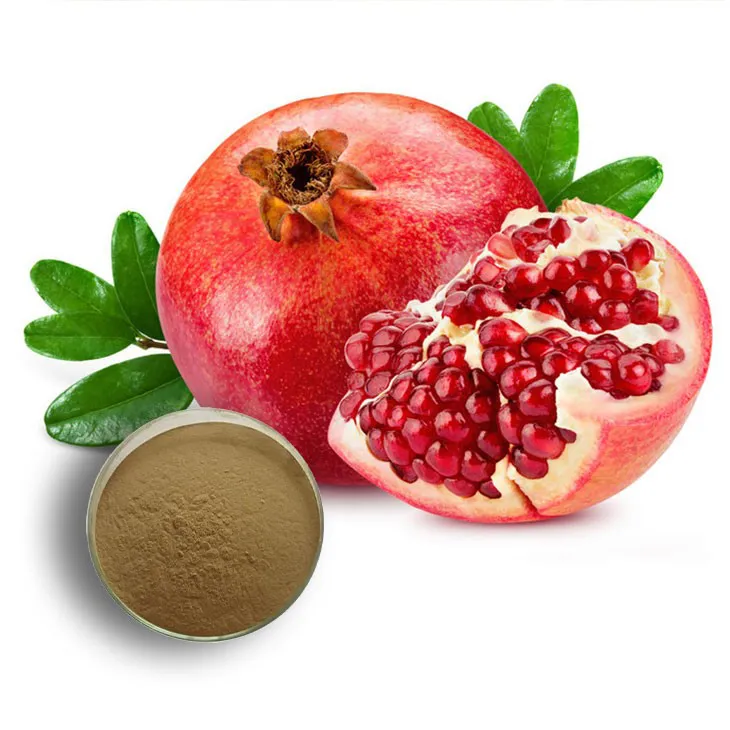- 0086-571-85302990
- sales@greenskybio.com
How to Extract Pomegranate Extract by Steam Distillation.
2024-11-26

1. Introduction to Pomegranate and Its Valuable Components
Pomegranate (Punica granatum) is a fruit that has been highly regarded for its numerous health benefits and rich nutritional profile for centuries. It is native to regions of the Middle East and has spread throughout the world due to its popularity.
Phenolic Compounds: One of the most important groups of components in pomegranate are phenolic compounds. These include flavonoids such as anthocyanins, which are responsible for the fruit's characteristic red color. Ellagic acid is another significant phenolic compound found in pomegranate. It has antioxidant properties that can help protect cells from damage caused by free radicals.
Vitamins and Minerals: Pomegranates are also a good source of vitamins, particularly vitamin C, which is essential for the immune system and skin health. In addition, they contain minerals such as potassium, which plays a crucial role in maintaining proper heart function.

2. Steam Distillation: An Overview
Steam distillation is a separation technique that is widely used in the extraction of essential oils and other volatile compounds from plant materials. The principle behind steam distillation is based on the fact that the vapor pressure of a mixture of two immiscible liquids (in this case, water and the volatile components of the pomegranate) is equal to the sum of the vapor pressures of the individual components at a given temperature.
When steam is passed through the pomegranate material, the volatile compounds are vaporized along with the steam. These vapors are then condensed, and the resulting liquid is a mixture of water and the desired Pomegranate Extract. Since the extract is usually less soluble in water, it can be separated from the water phase through further processing.

3. Step - by - Step Process of Steam Distilling Pomegranate Extract
3.1 Preparation of Pomegranate Materials
Harvesting: The first step is to ensure that the pomegranates are harvested at the right time. Pomegranates should be fully ripe for optimal extraction. Ripe pomegranates usually have a deep red color and a firm outer skin.
Cleaning: Once harvested, the pomegranates need to be thoroughly cleaned. Remove any dirt, debris, or damaged parts of the fruit. This can be done by gently washing the pomegranates in clean water.
Preparation of the Plant Material: After cleaning, the pomegranates can be cut open, and the seeds can be removed. The seeds are the main source of the volatile and valuable compounds. They can be further crushed or ground to increase the surface area available for extraction. However, it is important to note that excessive grinding may lead to the release of unwanted compounds or degradation of the desired ones.
3.2 Setup of the Distillation Apparatus
The Still: A suitable still is required for steam distillation. This can be a simple glass apparatus for laboratory - scale extraction or a larger, more industrial - scale setup. The still should consist of a boiling flask where the pomegranate material and water are placed, a condenser to cool and condense the vapors, and a collection flask to collect the distillate.
Connecting the Components: The boiling flask should be connected to the condenser in a sealed manner to prevent the escape of vapors. The condenser is usually cooled by a coolant such as cold water, which circulates around the condenser coils. The collection flask should be placed at the end of the condenser to receive the condensed liquid.
3.3 Control of Key Parameters
Temperature: Temperature control is crucial in steam distillation. The boiling point of water is 100°C at standard atmospheric pressure. However, in the presence of pomegranate material, the actual boiling point may be slightly different. A temperature range of around 100 - 110°C is often suitable for pomegranate steam distillation. Higher temperatures may cause the degradation of some of the valuable compounds, while lower temperatures may result in incomplete extraction.
Pressure: Maintaining the appropriate pressure is also important. In most cases, steam distillation is carried out at or near atmospheric pressure. However, in some advanced setups, slight variations in pressure can be used to optimize the extraction process. For example, a slightly reduced pressure may lower the boiling point of the mixture, which can be beneficial for heat - sensitive compounds.
Steam Flow Rate: The rate at which steam is passed through the pomegranate material affects the efficiency of extraction. A slow and steady steam flow rate is generally preferred. Too fast a steam flow may cause the vapors to be carried away before proper extraction occurs, while too slow a flow may lead to a long extraction time.

4. Quality Assessment of the Obtained Pomegranate Extract
Chemical Analysis: Chemical analysis is an important part of assessing the quality of the pomegranate extract. This can include the determination of the content of phenolic compounds, such as ellagic acid and anthocyanins. High - performance liquid chromatography (HPLC) is a commonly used technique for this purpose. It can accurately quantify the levels of different compounds in the extract.
Antioxidant Activity: The antioxidant activity of the extract is another key aspect of quality assessment. This can be measured using methods such as the DPPH (2, 2 - diphenyl - 1 - picrylhydrazyl) assay. A higher antioxidant activity indicates that the extract is rich in compounds that can scavenge free radicals and may have potential health benefits.
Microbial Contamination: Ensuring that the extract is free from microbial contamination is essential. Microbiological tests, such as total plate count and tests for specific pathogens, should be carried out. If the extract is intended for use in food, medicine, or cosmetics, strict microbial limits must be adhered to.

5. Potential Applications of Pomegranate Extract
5.1 In the Food Industry
Pomegranate extract can be used as a natural flavoring agent in various food products. Its unique taste can add a pleasant and fruity note to beverages, such as juices, smoothies, and alcoholic drinks. In addition, due to its antioxidant properties, it can also be used as a preservative to extend the shelf life of food products.
It can be incorporated into baked goods, such as cakes and muffins, to provide a nutritional boost. Some manufacturers are also exploring the use of pomegranate extract in functional foods, which are designed to provide specific health benefits beyond basic nutrition.
5.2 In the Medicine Field
Anticancer Properties: Some studies have suggested that the phenolic compounds in pomegranate extract may have anticancer properties. They may be able to inhibit the growth of cancer cells and induce apoptosis (cell death) in certain types of cancer. However, more research is needed to fully understand and confirm these potential benefits.
Cardiovascular Health: Pomegranate extract may also be beneficial for cardiovascular health. It has been shown to help reduce blood pressure, lower cholesterol levels, and improve blood flow. These effects may be attributed to its antioxidant and anti - inflammatory properties.
Anti - inflammatory Effects: Inflammation is associated with many diseases, and pomegranate extract has been found to have anti - inflammatory effects. It can help reduce inflammation in the body, which may be useful in the treatment of conditions such as arthritis.
5.3 In the Cosmetics Industry
Pomegranate extract is increasingly being used in cosmetics due to its antioxidant and anti - aging properties. It can be added to skin creams, lotions, and serums to protect the skin from damage caused by free radicals, which can lead to premature aging.
It can also improve skin hydration and elasticity. In hair care products, pomegranate extract can help strengthen the hair shaft, reduce hair breakage, and add shine to the hair.
6. Conclusion
Steam distillation is a valuable method for extracting pomegranate extract, which is rich in valuable components with potential applications in food, medicine, and cosmetics. By following the proper steps in the extraction process and carefully assessing the quality of the extract, it is possible to obtain a high - quality product that can be utilized in various industries. However, further research is still needed to fully explore the potential of pomegranate extract and optimize the extraction process for different applications.
FAQ:
1. What are the valuable components in pomegranate worthy of extraction?
Pomegranate contains various valuable components such as polyphenols, flavonoids, and tannins. These compounds possess antioxidant, anti - inflammatory, and other beneficial properties, which make them worthy of extraction for potential applications in different fields.
2. How should the pomegranate materials be prepared before steam distillation?
Before steam distillation, the pomegranate materials need to be properly prepared. Firstly, fresh pomegranates should be selected and washed thoroughly to remove dirt and impurities. Then, the seeds and arils are separated. The arils can be further crushed or mashed to increase the surface area for better extraction during the distillation process.
3. What is the proper setup of the distillation apparatus for extracting pomegranate extract?
The distillation apparatus typically consists of a distillation flask, a condenser, and a collection vessel. The pomegranate material is placed in the distillation flask. A heat source is used to heat the flask, and steam is generated. The condenser cools the vapor back into liquid form, which then drips into the collection vessel. The apparatus should be properly sealed to prevent steam leakage and ensure efficient distillation.
4. Why are temperature and pressure important parameters in steam distillation of pomegranate extract, and how to control them?
Temperature and pressure are crucial in steam distillation. Temperature affects the rate of vaporization of the components in the pomegranate. If the temperature is too low, the extraction may be incomplete, while if it is too high, it may lead to the degradation of some components. Pressure also influences the boiling point of the mixture. To control these parameters, a thermostatic device can be used to maintain a stable temperature, and a pressure - regulating valve can be installed to control the pressure within the appropriate range.
5. How can the quality of the obtained pomegranate extract be assessed?
The quality of the pomegranate extract can be assessed through various methods. One common method is to analyze its chemical composition using techniques such as high - performance liquid chromatography (HPLC) to determine the content of key components like polyphenols. Physical properties such as color, odor, and viscosity can also provide some indication of quality. Additionally, biological assays can be carried out to evaluate its antioxidant or anti - inflammatory activities.
6. What are the potential applications of pomegranate extract in the food industry?
In the food industry, pomegranate extract can be used as a natural antioxidant to extend the shelf life of food products. It can also be added to beverages, such as juices and wines, to enhance their flavor and nutritional value. Moreover, it can be incorporated into food products like jams and yogurts as a functional ingredient.
Related literature
- Steam Distillation of Pomegranate: Optimization of the Process for Extract Production"
- "The Role of Pomegranate Extract in Modern Medicine: Insights from Steam - Distilled Extracts"
- "Pomegranate Extract in Cosmetics: Steam Distillation and Its Impact on Product Quality"
- ▶ Hesperidin
- ▶ citrus bioflavonoids
- ▶ plant extract
- ▶ lycopene
- ▶ Diosmin
- ▶ Grape seed extract
- ▶ Sea buckthorn Juice Powder
- ▶ Beetroot powder
- ▶ Hops Extract
- ▶ Artichoke Extract
- ▶ Reishi mushroom extract
- ▶ Astaxanthin
- ▶ Green Tea Extract
- ▶ Curcumin Extract
- ▶ Horse Chestnut Extract
- ▶ Other Problems
- ▶ Boswellia Serrata Extract
- ▶ Resveratrol Extract
- ▶ Marigold Extract
- ▶ Grape Leaf Extract
- ▶ blog3
- ▶ blog4
-
Chinese Withania somnifera Extract Factory.
2024-11-26
-
中国松树皮提取物粉粉末供应商
2024-11-26
-
High - quality Marigold Extract Products.
2024-11-26
-
100% Pure Natural Mango - Flavored Powder.
2024-11-26
-
Moringa powder
2024-11-26
-
White Peony Extract
2024-11-26
-
Almond Extract Powder
2024-11-26
-
Scutellaria Extract
2024-11-26
-
Mangosteen extract powder
2024-11-26
-
Lily extract
2024-11-26
-
Curcumin Extract
2024-11-26
-
Pomegranate Extract
2024-11-26
-
Tormentil Extract
2024-11-26
-
Pine bark Extract Powder
2024-11-26




















